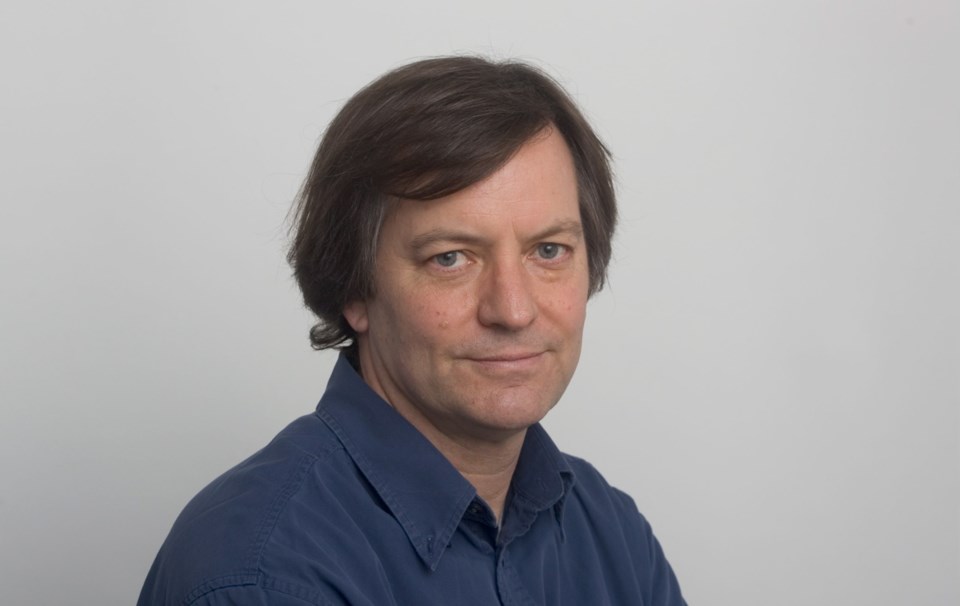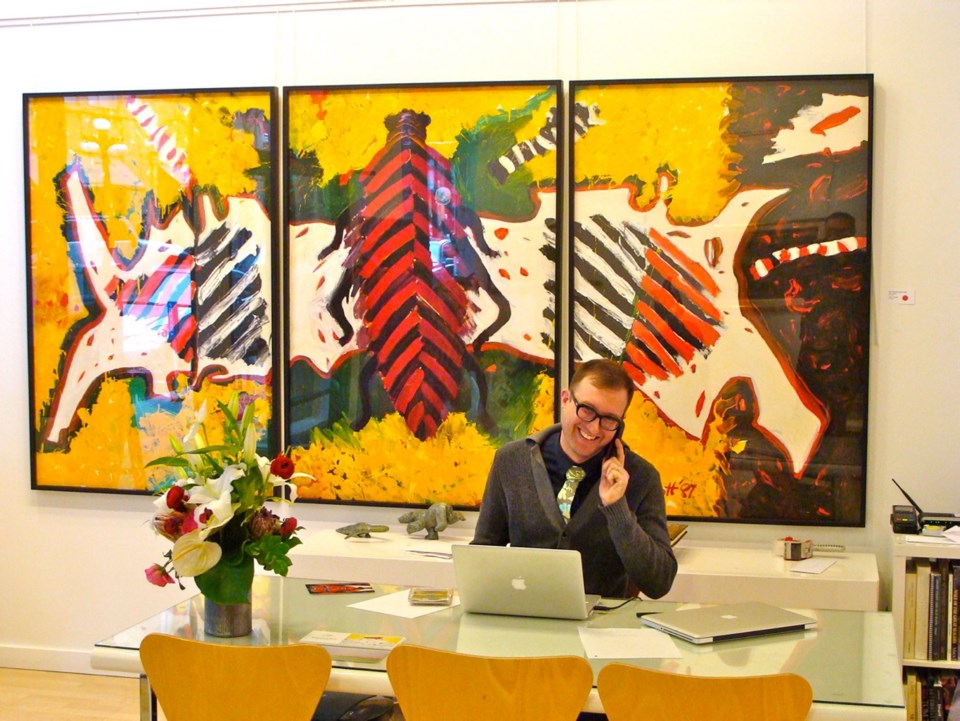Historic Canadian Art at Madrona Gallery, 606 View St., 250-380-4660, , until March 28.
 Probably the most expensive painting ever shown at Victoria’s Madrona Gallery is a 1966 canvas by the late E.J. Hughes of Duncan. It’s a moody view of Qualicum Beach under a lowering sky, with a solitary shore walker and his little black dog. The pebbles in the foreground repay close attention.
Probably the most expensive painting ever shown at Victoria’s Madrona Gallery is a 1966 canvas by the late E.J. Hughes of Duncan. It’s a moody view of Qualicum Beach under a lowering sky, with a solitary shore walker and his little black dog. The pebbles in the foreground repay close attention.
After 1991, Hughes could no longer stand to paint on canvas and began replaying his “greatest hits” in the chamber music of watercolour.
Two fine late Hughes paintings, Breaker Beach (2002) and Totem Poles at Kitwanga (1992) are also on show.
The Madrona Gallery has brought us some fascinating contemporary artists (Megan Hilderand, Morgana Wallace), and also carvings and works on paper by remarkable young Inuit. With the current exhibit of his “finds” from sales and private collections, proprietor Michael Warren’s interest in Canadian art history is prominently presented.
On a recent visit, Warren offered me a brief survey of our country’s art-making. We began with a little wooden panel by Group of Seven member J.E.H. MacDonald. In 1919, MacDonald went with Lawren Harris, A.Y. Jackson and Frank Johnson on a painting expedition in a specially outfitted “boxcar” to the Algoma region north of Lake Superior. With typically energetic brushwork and strong colour, MacDonald painted a place they called Varley Lake.
Nearby hangs St. Simeon, a tiny panel by Jackson. Painted on the north shore of the St. Lawrence River in 1923, it features a barn in snow, rolling hills and a distant view of the wintery river, all typical Jackson motifs.
A similar subject is offered in a drawing, the slightest notation fresh from Jackson’s hand. Such pencil sketches don’t have much decorator value, but put the connoisseur immediately in touch with Jackson’s moment of inspiration.
A small oil by Fred Varley appears to show distant mountains and waters at sunset. With bruised colour and clotted forms, this rough bit of oil paint is not one of his best. A silhouette of someone — the unhappy painter? — stands in the bottom left corner contemplating the scene. Varley was an alcoholic and during his years on the West Coast, from 1926 to 1936, he swerved from egomania to depression.
Madrona Gallery has brought forth an interesting painting of Kitwancool by Emily Carr. Carr stayed in the area, 30 kilometres north of the Skeena River, for five rainy days in 1928 and found it rich in totems and hospitality.
On returning to her Victoria studio, she worked up this large sketch on a panel, brushing out the image in diluted oil paint with a watercolour technique, an approach that later evolved into her oil-on-paper landscapes.
To complete his “old masters” section, Warren offers a highly resolved field study by Harris, showing the Colin Range in Alberta, and dating from 1928. Such little oil-on-panel studies have become the gold standard of Canadian art collections. This one offers a smooth body of water in the foreground, sweeping back to distant hills before rising to a crescendo of snow-peaked mountains.
Across the room are two works on paper by LeMoine FitzGerald of Winnipeg who, in 1932, was invited to be the 10th — and last — member of the Group of Seven. The larger of the two is a highly finished watercolour of three pots on a windowsill: a classic FitzGerald study of his personal space.
Beside it is a small ink drawing that really gets down to the essence. It’s a view looking out FitzGerald’s window to the snowy back lanes of Winnipeg, but the technique is more remarkable than the subject. Weaving a pointillist mesh of dots and dashes, he has created an energy field that hangs together like particle physics.
During FitzGerald’s last years, Joe Plaskett was the young principal of the Winnipeg School of Art. Later, after training in New York with Hans Hoffman, Plaskett set up as our Canadian in Paris.
Among other pastels, Madrona Gallery has a vivid 1959 picture of Paris and the Seine, with spring showers coming on.
Takao Tanabe was a student at the Winnipeg school during Plaskett’s time there, and also went to New York to study with Hoffmann. Madrona presents works from three phases of Tanabe’s career.
First is a white gestural abstraction from the late 1950s. Next, a rare ink landscape from 1960 speaks of Tanabe’s Japanese heritage, as well as his childhood on sa���ʴ�ý’s northwest coast. In a later, larger foothills scene from his time teaching at the Banff School of Fine Art, Tanabe merged landscape motifs with the popular modes of the time: geometric and colour field abstraction, and minimalism.
Toni Onley also went from abstract to representational art. In 1961, at the end of his time in Mexico, Onley tore up his paintings on paper and pasted them onto board. These are among his most popular works, and Madrona’s large panel titled Windermere (1961) is a fine example. It is paired with his later landscape, an oil of Mount Cheam.
Gordon Smith is well represented with an early vase of flowers and two well-chosen abstract canvases.
The collection comes to a rousing conclusion with two three-part paintings by Jack Shadbolt. Behind Michael Warren’s desk is the powerful triptych titled Bug. Hip Bones. Rhino.
These Shadbolt offerings are major West Coast works by any standard and worth consideration by local painters — and collectors.



